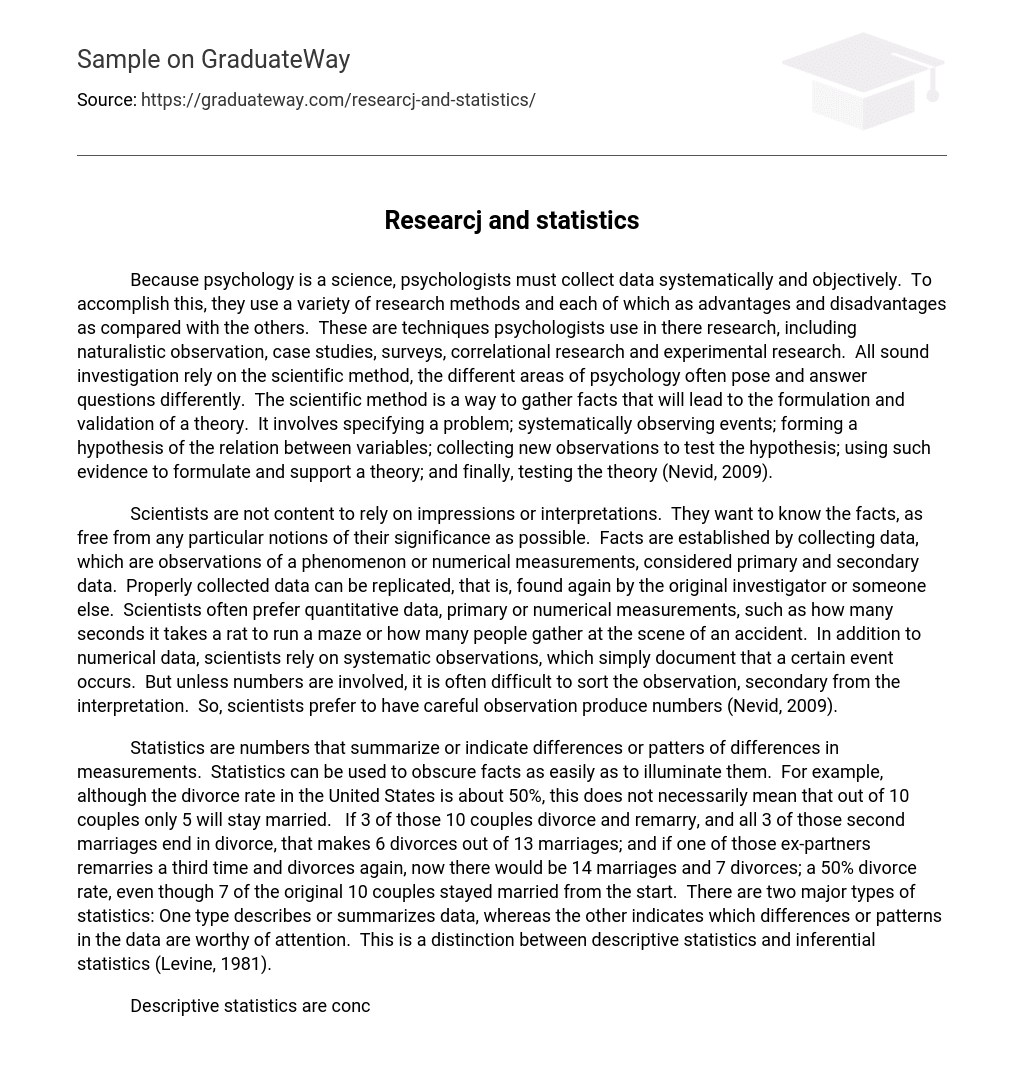Because psychology is a science, psychologists must collect data systematically and objectively. To accomplish this, they use a variety of research methods and each of which as advantages and disadvantages as compared with the others. These are techniques psychologists use in there research, including naturalistic observation, case studies, surveys, correlational research and experimental research. All sound investigation rely on the scientific method, the different areas of psychology often pose and answer questions differently. The scientific method is a way to gather facts that will lead to the formulation and validation of a theory. It involves specifying a problem; systematically observing events; forming a hypothesis of the relation between variables; collecting new observations to test the hypothesis; using such evidence to formulate and support a theory; and finally, testing the theory (Nevid, 2009).
Scientists are not content to rely on impressions or interpretations. They want to know the facts, as free from any particular notions of their significance as possible. Facts are established by collecting data, which are observations of a phenomenon or numerical measurements, considered primary and secondary data. Properly collected data can be replicated, that is, found again by the original investigator or someone else. Scientists often prefer quantitative data, primary or numerical measurements, such as how many seconds it takes a rat to run a maze or how many people gather at the scene of an accident. In addition to numerical data, scientists rely on systematic observations, which simply document that a certain event occurs. But unless numbers are involved, it is often difficult to sort the observation, secondary from the interpretation. So, scientists prefer to have careful observation produce numbers (Nevid, 2009).
Statistics are numbers that summarize or indicate differences or patters of differences in measurements. Statistics can be used to obscure facts as easily as to illuminate them. For example, although the divorce rate in the United States is about 50%, this does not necessarily mean that out of 10 couples only 5 will stay married. If 3 of those 10 couples divorce and remarry, and all 3 of those second marriages end in divorce, that makes 6 divorces out of 13 marriages; and if one of those ex-partners remarries a third time and divorces again, now there would be 14 marriages and 7 divorces; a 50% divorce rate, even though 7 of the original 10 couples stayed married from the start. There are two major types of statistics: One type describes or summarizes data, whereas the other indicates which differences or patterns in the data are worthy of attention. This is a distinction between descriptive statistics and inferential statistics (Levine, 1981).
Descriptive statistics are concise ways of summarizing properties of sets of numbers. Descriptive statistics include measures of central tendency, such as the familiar arithmetic average. But descriptive statistics are not just limited to figures and tables. Inferential statistics are the results of tests that reveal whether differences or patterns in measurements reflect true differences in the population, or just chance variations. For instance if you toss a coin 10 times and it lands heads up 7 times, instead of 5 you would expect purely by chance, does this mean that it is a trick coin or an edge is worn away, or could this outcome also arise from just chance? Inferential statistics seek to address this question of whether patterns in a set of data are random, or if they reflect a true underlying phenomenon. A correlation is an example of inferential statistics; if the correlation is high enough it tells you that the scores on one variable do in fact vary systematically with the scores of another variable (Levine, 1981).
Remember that statistics can be used or misused. Because different types of statistics convey different information, the same data can be manipulated to say different things. Some are just presenting different aspects of the data. Many results are presented in graph form. Larger bars, higher lines or bigger wedges all stand for greater amounts than smaller bars, lines or wedges. Our tendency to see more on the page as standing for more of a substance, can lead us astray if the graphs are constructed to deceive. The crucial ideas are that there are measures of central tendency (mean, median and mode), measures of variability (range and standard deviation), and statistical tests that tell you the likelihood that a measured difference is due to chance alone. Learning statistics will help in reading and understanding many reports of original research in psychology. Statistics can be defined as any numerical piece of data. In its plural form, statistics as well as in the term statistical methods, reference is being made to strategies, tools and techniques for gathering, describing, analyzing and drawing conclusions about data (Nevid, 2009).
Reference:
Levine, G. (1981). Introductory statistics for psychology: The logic and the methods. New York: Academic Press.
Nevid, J.S. (2009). Psychology: Concepts and applications. Boston: Houghton Mifflin Co.





